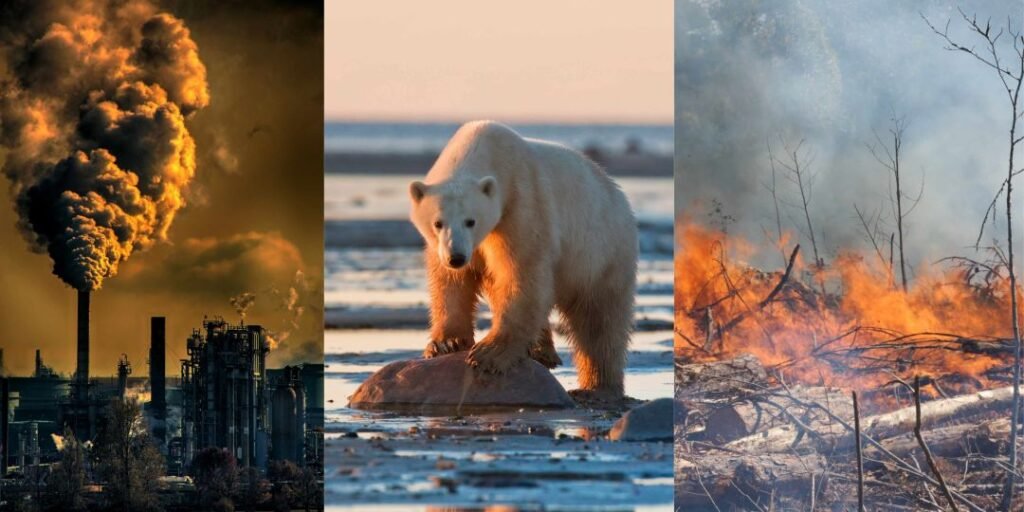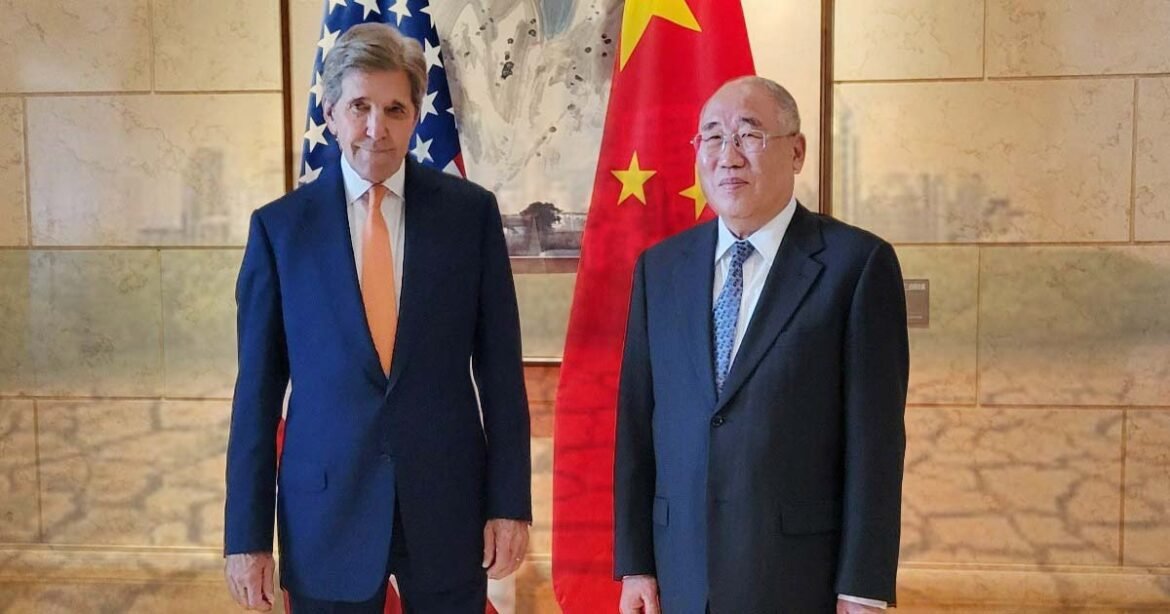The two largest economies in the world aim to work together and restart climate negotiations as John Kerry reached to Beijing on Sunday for a long-awaited visit.
John Kerry, the US envoy to China, arrived in China on Sunday, embarking on a four-day of negotiation that will put to the test the ability of the US and China to tackle global warming, despite deep-seated disagreements on various other issues. This visit represents the latest diplomatic endeavor aimed at reestablishing ties between the two superpowers, which have experienced strain due to conflicts surrounding export controls, human rights concerns, and the notable visit of former House Speaker Nancy Pelosi to Taiwan in August of the previous year.
This will also be the first protracted climate negotiations between the two nations in nearly a year, after Beijing severed dialogue on climate change and other issues following Pelosi’s controversial visit.
Kerry is the third member of the US cabinet to visit China in recent weeks, as the Biden administration intensifies its efforts to repair shattered communications and stabilize fraught relations with Beijing. US Secretary of State Antony Blinken met Chinese leader Xi Jinping in Beijing last month, and US Secretary of the Treasury Janet Yellen met China’s Premier Li Qiang last week. Adding to these efforts, Blinken also engaged in discussions with China’s top diplomat Wang Yi in Jakarta during a summit.
What is this visit about?
These two nations make up the bulk of the world’s investment in renewable energy, with China alone accounting for more than half of the total. But they are also the world’s two largest carbon emitters, making them the ‘G2 of energy consumption, energy use, and pollution,’ according to Dan Kammen, energy professor at the University of California, Berkeley.Together they spew about 40 percent of greenhouse gases into the atmosphere.
“So both are making major steps, but neither are actually seeing emissions fall yet,” he told.
“In the wake of Covid and ever-worsening US-China relations, climate change promises to be an area where productive collaboration can benefit our two countries and the rest of the world,” said Alex Wang, a professor of Law at the University of California, Los Angeles and an expert on Chinese climate policy.
“Each country now has major programs in place to invest in and promote de-carbonization, but neither side is moving quickly enough,” he added.
The United States intends to reduce emissions by nearly 50 percent and reach carbon neutrality by 2050. China has pledged to increase its greenhouse gas emissions until 2030, when it will begin a decline, with the ultimate goal of reaching carbon neutrality by 2060
Commitments and initiatives to tackle climate crisis
The United States and China have taken significant measures to combat climate change, as evidenced by their participation in the 2015 Paris Agreement. This historic agreement resulted in a joint commitment, putting decades of disagreements on carbon pollution to rest, and persuaded other nations to assume collective responsibility for combating climate change.

In this decade, the United States intends to reduce emissions by nearly 50 percent and reach carbon neutrality by 2050. China has pledged to increase its greenhouse gas emissions until 2030, when it will begin a decline, with the ultimate goal of reaching carbon neutrality by 2060. Both nations are advancing toward their near-term objectives, with the United States investing $370 billion in clean energy and instituting regulations to reduce pollution. China leads the world in the production of electric vehicles and solar energy, but coal consumption remains a pressing concern as the construction of coal power plants intensifies in response to a renewed emphasis on ‘energy security.’
What does US and China want from this visit?
Experts predict that significant announcements are unlikely to be made during this visit; however, the discussions are of great significance. Kerry is expected to meet with prominent Chinese officials, including his counterpart XieJianbo, Vice Premier Ding Xuexiang, and a vice minister of ecology and environment, while in Beijing.
During the meeting, the John Kerry-led U.S. delegation intends to collaborate with China on three crucial climate issues: reducing methane emissions, combating deforestation, and phasing out China’s coal consumption. In addition, the United States intends to convince China to set more ambitious climate goals, including an earlier emissions peak.
China, which has a reputation for achieving its goals, wishes to highlight the progress it has already made in meeting its climate objectives and the policies it has implemented to achieve them. China is positioning itself as a champion of the developing world by emphasizing that its average pollution per person is lower than that of many affluent nations.
While China recognizes the United States’ influence in other areas, such as trade, it expects that progress on climate issues will help improve bilateral relations.
Contradictions and complexity of climate goals
Both the United States and China face difficulties in achieving a balance between economic growth and emission reduction, resulting in contradictory actions that have attracted the criticism of environmentalists. The United States permitted new oil and gas projects but did not fulfill its financial obligations to assist less developed countries in their move away from fossil fuels, therefore difficulties still exist. Meanwhile, the global effort to tackle climate change is in jeopardy due to China’s expanding coal usage.
China has previously demonstrated a commitment to lowering its reliance on coal and setting carbon neutrality objectives, but recent blackouts and rising energy demands have led a shift back to prioritizing energy security, leading to an increase in coal power.
The rapidity of China’s shift away from coal, according to UCLA researcher Wang, would be a prominent topic of discussion for Kerry.
For China’s climate strategy and long-term emission reduction goals, finding a balance between the transition to renewable energy sources and the phase-out of coal remains a difficulty.
Both nations must work together to assist and inspire one another while proving their sincerity to the rest of the world because they both have a long way to go in achieving their climate goals.
Hopes for cooperation
After a year of very heightened tensions, the two superpowers’ leaders have begun to speak again. Kerry expressed expectations that the climate talks could be shielded from geopolitical hostility, but Chinese officials disregarded that notion.
In a meeting in Bali in November last year, Presidents Biden and Xi Jinping of China agreed to resume talks with their senior officials. However, those efforts failed earlier this year when a Chinese spy balloon was detected flying over the United States. This sparked outrage in Washington, and Beijing later slowed the resumption of negotiations.
John Kerry’s visit to China as the Special Presidential Envoy for Climate of the United States has highlighted the need of cooperation on climate concerns between the two countries. The discussions between Kerry and Chinese leaders, including President Xi, could indicate domestic political pressure on both sides to work together and urgently confront the global climate problem, which calls for cooperation beyond strategic competition and geopolitical conflicts. In order to expedite carbon reductions and address the climate challenge with coordinated efforts, it is hoped that a newfound amity will be achieved, similar to the unexpected joint accord reached at the 2021 COP summit.
Negotiating their diplomatic disagreements will be necessary to make substantial progress, but experts stress the importance of cooperation in resolving the global climate catastrophe. The joint working group on climate cooperation is hoped to resume and communication to remain open in the months before the UN climate summit in Dubai in November this year.
To conclude, despite the low expectations for major breakthroughs during this visit, establishing regular US-China meetings on climate change would be a positive step and set the stage for more tangible outcomes in the future.


